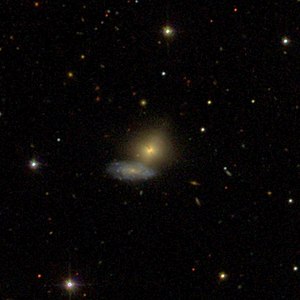NGC 6088
| Galaxy NGC 6088 |
|
|---|---|

|
|
| SDSS recording | |
| AladinLite | |
| Constellation | Dragon |
|
Position equinox : J2000.0 , epoch : J2000.0 |
|
| Right ascension | 16 h 10 m 43.5 s |
| declination | + 57 ° 27 ′ 51 ″ |
| Appearance | |
| Morphological type | Sbc E-S0 |
| Brightness (visual) | 15.2 mag 15.0 mag |
| Brightness (B-band) | 16.0 mag 15.8 mag |
| Angular expansion | 0.7 ′ × 0.3 ′ 0.7 ′ × 0.3 ′ |
| Position angle | 138 ° 96 ° |
| Surface brightness | 13.4 mag / arcmin² 13.4 mag / arcmin² |
| Physical data | |
| Redshift | 0.032 |
| Radial velocity | 9600 km / s |
|
Stroke distance v rad / H 0 |
(440 ± 31) · 10 6 ly (135.0 ± 9.4) Mpc |
| history | |
| discovery | Wilhelm Herschel |
| Discovery date | April 24, 1789 |
| Catalog names | |
| NGC 6088 • PGC 57383/4 • CGCG 298-013 • MCG + 10-23-29, + 10-23-30 • IRAS F16097 + 5735 • GC 4171 • H III 812 • | |
NGC 6088 is a gravitationally bound double galaxy, consisting of the 15.2 mag bright spiral galaxy PGC 57383 ( Hubble type Sbc) and the 15.0 mag bright elliptical galaxy PGC 57384 (Hubble type E-S0).
NGC 6088 is located in the constellation Dragon and was discovered on April 24, 1789 by Wilhelm Herschel with an 18.7-inch reflector telescope, who described it as "vF, vS, lE".
